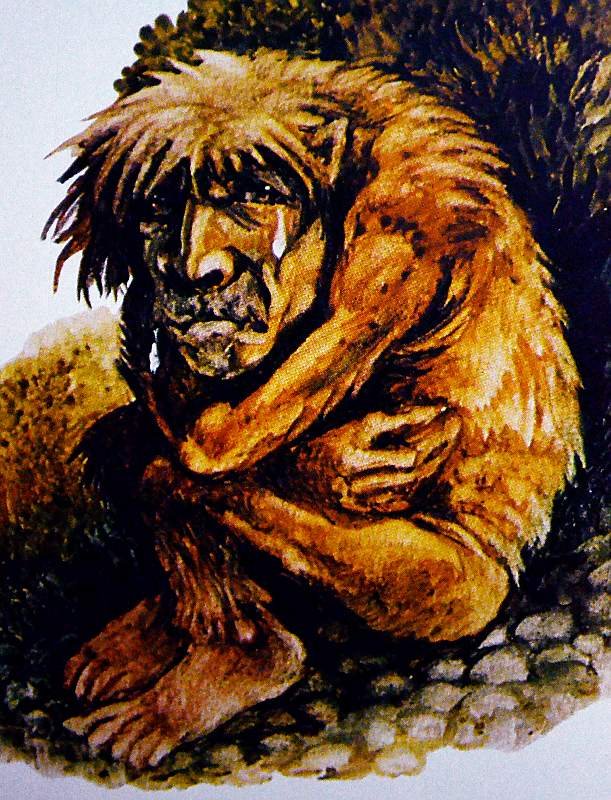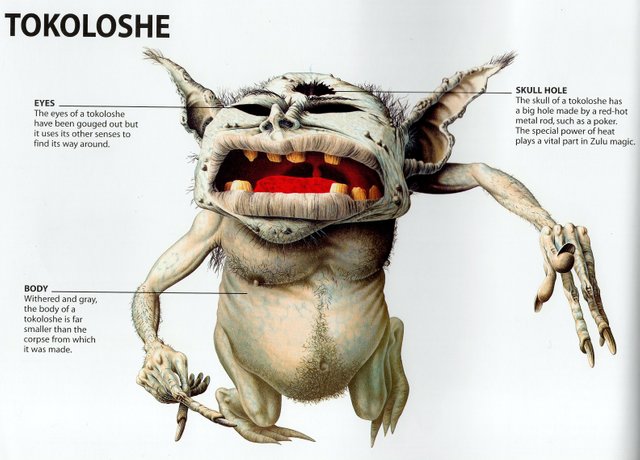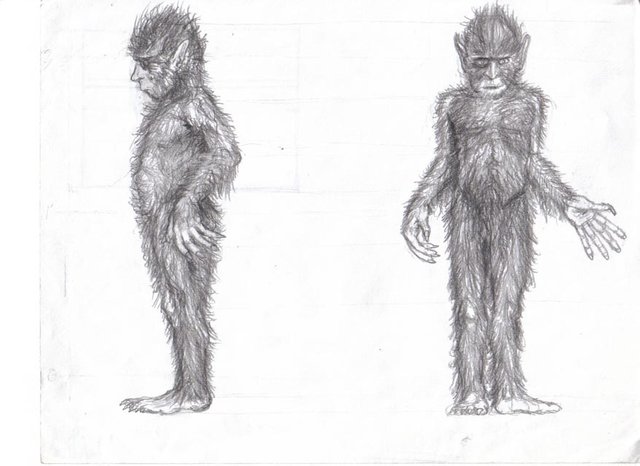The Tokoloshe

The familiar of witches and sorcerers most feared by
the Bantu is the tokoloshe (the dwarf). In her book
Suspicion is my name, Barbara Tyrrell, a renowned
authority on Bantu folklore, describes the tokoloshe
as follows:
‘_ _ _ it is the same height as the manzindane (fairy
man) but it has a wider body. It also has smooth
ochre-coloured body-fur, has hair hanging over
the forehead, a small moustache, hair on the feet
and backs of the hands but none on the palms. The
hands and feet are small like those of a monkey. It
has hairy ears pressed back against the skull and a
penis that looks more like a tail and is indeed
referred to as a “tail”.
The hair on the head is longer than that of the
body and its eyes are black, small and narrow. It
wears no clothes and lives in holes among stones
and in the river. This is a wild creature and ...is
not itself bad. It is used by evil wizards who catch
it in the river, kill it and make it into medicine,
creating a live yet not a live thing. This creation of
their own magic is then their servant for evil.’
The malevolence behind this macabre being does not
spring from the tokoloshe himself but from his evil
master, the sorcerer, whose main aim and pleasure in
life is to cause misery and strife among his fellow men.
It is the sorcerer who sends the tokoloshe on his wicked
errands. The tokoloshe’s main asset is his ability to
render himself invisible. Unseen, he can creep into a
hut to place poison in strategic places, or hide a buck’s
horn filled with vile concoctions in the thatch or in the
river mud near the spot where the drinking pots are
filled. While a victim is eating the tokoloshe can even
drop a little bad medicine into the spoon of food he or
she is about to swallow.

Catching Tokoloshe
The tokoloshe’s undoing often comes through his crav-
ing for fresh milk, which he drinks straight from the
cow’s udder. To cover this theft, he lets the calves into
the kraal with their mothers, so that the farmer is fooled
into thinking that it is they that have drunk all the milk.
After a while, it usually occurs to the man that he is
being robbed by a tokoloshe and he employs the ser-
vices of a witchdoctor or herbalist. As the tokoloshe
always enters the kraal from the rear end of the enclos-
ure, the herbalist sets his traps there. He draws a magic
circle and sprinkles his enchanted medicine where he
knows the dwarf will walk. If the tokoloshe falls into the
trap, he will stand there paralysed, with his powers of
invisibility destroyed. He cannot move a finger, but if a
person shouts, or exclaims, ‘Lookl A tokoloshel’ he will
vanish immediately, as the spell will be broken. There-
fore the herbalist must make sure that he personally
captures the dwarf. This results in a sticky end for the
tokoloshe, for he is ground up, fat and bone, and turned
into strong medicine to be used by the herbalist to catch
others of his kind - a service for which the herbalist is
well rewarded!
Tokoloshe and the Girls
On a fine spring morning, five merry girls from a
nearby village came to swim in the river. They splashed
and shrieked so loudly that a tokoloshe which lived
under the river bank was awakened from his slumbers
by their rowdy behaviour. ‘All right thenl’ he thought.
‘I’ll show them that I can play that game tool’ Sounder
the water he swam, and tickled and pinched the girls.
Soon screams of fright mingled with the laughter. The
villagers became alarmed by the noise the girls were
making and came down to the river to see what was
happening.
There were the girls, yelling in both mirth and fear.
The wisest elder recognised the signs of the tokoloshe.
‘Come out of the water at once,’ he shouted.
‘We cannot,’ spluttered the girls, ‘we are stuck fast to
the bottom of the stream, and something is tickling and
pinching us! Ooh oohl’ The old man shouted for the
young men.
‘You must jump into the water to free the girls,’ he
ordered. These instructions were obeyed with alacrity
and in no time at all the girls were carried safely ashore.
This situation has no doubt been exploited many times
without the intervention of a tokoloshe - but neither the
girls nor the youths ever declared any ill effects from
their adventure.
Tokoloshe and the Children
Some people maintain that the tokoloshe is much
maligned and that he is really a mild little creature who
lives peacefully on lonely river banks, and is particu-
larly fond of children. When he can, he will lure these
boon companions away from their frog-catching and
swimming, and will lead them into the ferny coolness of
the bank where he will spread a delicious feast and
delight in seeing them fill their round tummies to burst-
ing point. Of course, when they return home in the
eveningthey refuse to eat supper, as they long for the
delicacies of the tokoloshe’s forbidden banquets. They
are sworn to secrecy, however, and will never tell where
they are meeting their friend. Only by following the
children can the worried parents hope to find the secret
meeting place. The minute the tokoloshe suspects that
he is being watched by an adult, he will pop a magic
pebble into his mouth and vanish at once. g
There is a story that once a child repaid the
toko1oshe’s generosity by stealing this pebble while the
dwarf was swimming in the stream. Cf course the child
at once became invisible and the tokoloshe spent a
frantic morning chasing after the crack of a breaking
twig, swishing grass, and the giggles of the unseen
child. At last the creature could bear it no longer; he
burst into sobs of misery, letting the tears trickle down
his furry cheeks. Even the offender wastouched by this
sad sight, and returned the tokoloshe’s pebble to him.
However the tokoloshe never regained his complete
trust in children, and this is why he is seen so rarely.

The Herd Boy and the Tokoloshes
A man had many sheep and goats, but owing to his great
fondness for beer, and attending parties where it flowed
freely, he was not able to herd them as well as he might
and they were always straying and getting lost, or being
taken by wild animals. He asked the headman of an
umzi (kraal) to lend him a herd boy. The headman
agreed, and a suitable boy was found who went off with
the beer-drinker to his kraal. At dawn the boy rose,
drove out his new master’s numerous sheep and goats to
graze, and joined the other young herders to spend a
pleasant day in their company. In the evening he
returned home, milked the cows and shut up the stock.
He was given food in his own hut, but no sooner had he
sat down to eat than many short, hairy people entered-
men, women and children - all tokoloshes. They ate
nearly all his food, and he was too frightened to protest.
The next day he again went out to herd, and when he
came home the same thing happened: as soon as he
received food, his unwelcome visitors trooped in and
atc it all, leaving him to go hungry. This continued until
one of his companions asked him, ‘Why do you look so
bony and thin, as if you would break in two, when your
master has so many animals in milk ?' The boy replied:
‘When I sit down to eat, baboon-like animals come and
eat my food.’ . .
‘How can you see them?’ asked his friend. ‘
‘They have given me umzhi to rub on my eyelids so I
can see them.’
‘Let us go over to your umzi, no-one is there now as
everyone is at a beer party. I will take my lunch with me
to hire your visitors,’ offered his friend, and the two
went to the house of the herd boy’s master, rubbed the
medicine on their eyelids, and sat down to eat. In
trooped the tokoloshes to take their food. This time,
however, the herd boy seized his stick to thrash them,
and the tokoloshes ran out in consternation at this
violent behaviour. Une, a child, fell in its haste, and the
boy killed it with one blow of his stick. Then the two
boys, scared at what they had done, ran off and hid in
the bushes of a nearby hillock. They soon saw the
owner of the umzi coming to find out what had caused
the noise. When he saw the dead tokoloshe child, he
grabbed it and went off to bury it furtively in the
garden. ‘I am not going back to my own umzi,’ said the
herd boy, and off he went, leaving his former master to
retrieve his stock from the veld himself. '
The man was annoyed, and went and complained to
the headman. ‘The boy has left me without noticel’ The
headman called the boy.
‘My child, why did you run away?’
The boy was nervous. ‘I did not wish to live any
longer with this man. I fear the tokoloshes at his umzi
because I killed their child.’ .
The man replied angrily, ‘There are no tokoloshes at
my umzi.’
‘If you deny it, I will accuse you again,’ said the boy
heatedly.
‘Very well, accuse me.’
The boy accused him, saying, ‘This man hired me to
look after his herds, then he sent tokoloshes to eat my
food. At that umzi I was always hungry and ate
nothing.’
‘Rubbishl’ retorted the man. ‘The boy is lying.
There is nothing of the sort.’ I
‘Uh yes there is,’ cried the boy. ‘When I killed the
tokoloshe child, you ran and buried it in the garden for
fear of punishment.’
The man knew that he had been observed. ‘Oh, let us
forget all about this nonsense,’ he blustered, ‘it is clear
that the boy does not want to come and work for me. I
will forgive him and let the matter drop.’
So the boy was not punished, and the man was left to
look after his livestock himself, as no herd boy would
dare to work for him for fear of his tokoloshes ...

Tokoloshe.
The Pondo belief in this creature is shared by many of
the tribes of Southern Africa, especially the Xhosa
and Zulu. Tokoloshe, also known as Hili or Gilikango,
is described by the Pondo as a small hairy being with a
man’s form, but so small he only reaches to the average
person’s knee. He has hair all over his face and hair
coming out of his ears, and his face is like that of a
baboon or monkey. The penis of the male is so long that
he carries it over his shoulder, and he has only one
buttock. Both the male and female of the ‘species’
seldom wear clothing; if they do, it is made of skins.
Tokoloshe speaks with a lisp and live in crevices and
under river banks.
In addition, tokoloshe carries a charm which renders
him invisible to adults other than those who possess
him as a familiar. He can also be seen by children.
Some Pondo say that they can clearly remember
seeing tokoloshe as children, and recall having spent
pleasant days playing with him in the veld. Now, as
grown-ups,they see him no more. One among them
tells that one day, on his return from herding the flocks
as a child, he informed his parents that he had spent the
day at play with tokoloshe. The next morning being
very hot, he and his companions left their blankets off
and went to play in the cool reeds of the river bed.
When they returned later, they found tokoloshe sitting
with a blackened heap of smoking ashes before him. He
nodded portentously. ‘Yes,’ he said, ‘those are your
blankets. You see what happens to children who betray
me to grown-ups, The man also described how often
tokoloshe would come into the house at mealtimes and
filch the food from the adults’ plates, seen only by the
children.
Away from the influence of witches and sorcerers,
tokoloshe is merely mischievous, seldom evil. He wan-
ders at will, getting up to childish pranks - causing
havoc in a hut by spilling the milk, filling all the
calabashes with water, pilfering, fiddling, stealing
sweetmeats and sugar. Doubtless it is tokoloshe who
takes the blame for the deeds of many a recalcitrant
member of the family! '
Tokoloshe only becomes dangerous when he has
been caught and made the familiar of a witch, who uses
him to carry out many evil deeds. His hair is cut short
(this keeps him in a docile state) and he is housed in a
special storage hut. Nobody is specific about how
tokoloshe harms people. Some say that he has an
ikhubalo, or charm, that causes sickness, others that he
beats his victims, particularly when they have gone to
sleep. Tokoloshe, however, has a mind of his own, and
sometimes disobeys the orders of his master or mis-
tress. Several stories are told about him taking pity on
his victims and sparing them of his intended evil. This
is usually the case when he has been sent out against a
child.
A woman igqwira, or witch, always has a male
tokoloshe, who is her lover. A few maintain that men
have a female tokoloshe, but others disagree, saying
only women possess tokoloshe; indeed, those accused
of possessing him are almost always women. It is Said
a woman will always pass her tokoloshe on to her daugh-
ter. If the girl will not have him, he is insulted and kills
her. Parents instruct their children to tell them if they
see a short, hairy, little man and beat them if they admit
to playing with tokoloshe in the bush. A child who
grows up knowing tokoloshe may keep his friend into
adulthood; in this case the child becomes an umzakazhi
(sorcerer).
Tokoloshe is killed by doctors who sell his fat and
hair as a protective medicine against him. He does not
like dogs chasing him, and is terrified of mousetraps. A
blade of grass smeared with tokoloshe fat will float
upstream.
The fear and distrust in which tokoloshe is held has
led to tragedies. In 1933 a case came before the Appeal
Court at Butterworth concerning a man, Mbombela,
who had killed a child because he had mistaken it for
tokoloshe. Apparently, some children playing outside a
disused hut had seen through the chink of the door
something that had two small feet like those of a human
being. Frightened, they had called the young man,
Mbombela. He believed that what they saw was
tokoloshe§ and rushed in and killed him with a hatchet.
On dragging him out, however, hediscovered he had
killed a child. Mbombela was found guilty of murder,
but the charge was reduced to culpable homicide by the
Appeal Court on the grounds that Mbombela had
genuinely believed he was killing tokoloshe.